|
- A
Realistic and Authentic Re-creation
- of
Life-size Dinosaurs
- and
the prehistoric world in which they lived
-
- Dramatic, life-size
replicas of nine different types of dinosaurs are shown in their
natural prehistoric environment in this fascinating and educational
Sinclair Oil Corporation exhibit at the New York World's Fair.
-
- A reenactment of
life on earth as it was some 60-million to 180-million years
ago, the Sinclair exhibit displays realistic reproductions of
dinosaurs ranging in size from the 6-foot-long Ornitholestes
to the giant 70-foot Brontosaurus, one of the largest land creatures
that ever lived.
|
-
The
dinosaurs shown in SINCLAIR DINOLAND were constructed by Louis
Paul Jonas Studios. Technical consultants were the late Dr. Barnum
Brown, Curator Emeritus of the American Museum of Natural History,
and Dr. John H. Ostrom, Assistant Curator, Division of Vertebrate
Paleontology, Peabody Museum of Natural History, Yale University.
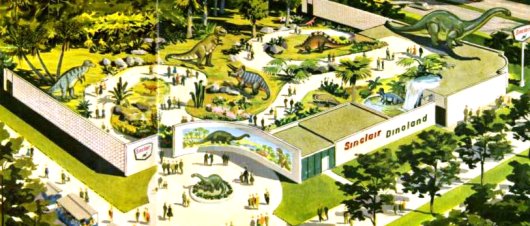 |
|
|
- Brontosaurus
- (Bront-o-sawr-us)
-
- One of the largest
and best-known dinosaurs. Called "Thunder Lizard" because
the ground supposedly shook when he walked. He was 70 to 80 feet
in length and weighed about 20 tons. His very long neck probably
enabled him to feed on underwater plants in marshes and streams.
He lived in North America, during the Jurassic Period some 135-
to 180-million years ago.
|
-
On
the following pages are the other dinosaurs featured in the SINCLAIR
DINOLAND World's Fair exhibit.
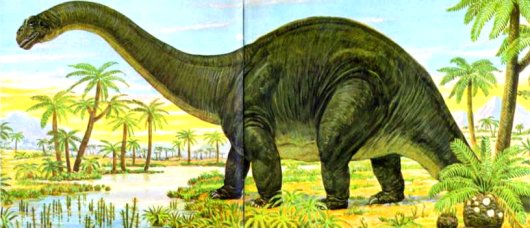 |
|
|
-
STRUTHIOMIMUS (Stru-thi-o-mi-mus)
looked like an ostrich, with his long hind limbs and small, hard
beak. The name means "ostrich mimic." He was approximately
14 feet long, 7 or 8 feet high. His front legs had clasping fingers
and curved claws. He had large eyes and a slender neck. He probably
ate fruits and vegetation and perhaps the eggs of other dinosaurs.
Struthiomimus lived in the Cretaceous Period in North America
some 63- to 135-million years ago.
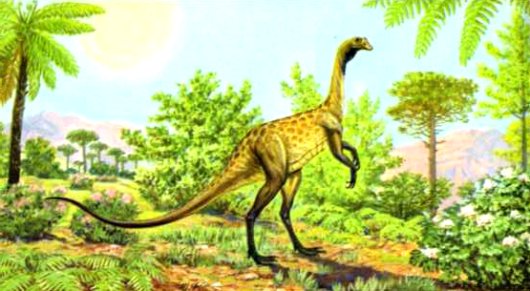 |
|
|
-
TRACHODON (Trak-o-don)
was a plant-eater. He could walk either on his hind legs or on
all fours. The name means "rough tooth." Some trachodons
had 1,500 teeth, so arranged that, as one row wore out, another
row replaced it. But these many teeth were useless as weapons
against flesh-eating dinosaurs. Trachodon was a duck-billed,
web -footed dinosaur, about 32 feet long and 14 feet high. He
lived in North America in the late Cretaceous Period.
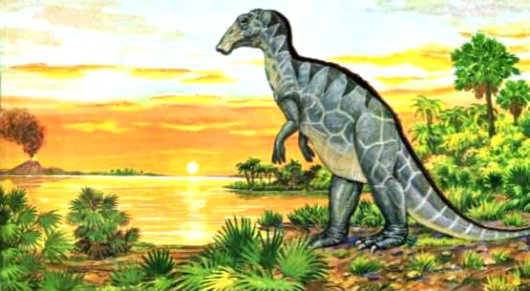 |
|
|
-
TYRANNOSAURUS (Tye-ran-o-sawr-us)
Largest and most terrifying flesh-eater that ever lived. His
teeth were 6 inches long, like daggers with sharp, serrated cutting
edges. He measured 50 feet from tip to tip, and his head rose
18 to 20 feet above the ground. Known as "Tyrant Lizard,"
this ferocious giant spelled death and destruction to most other
creatures. He existed in Montana in the late Cretaceous Period.
Tyrannosaurus reigned supreme for many millions of years.
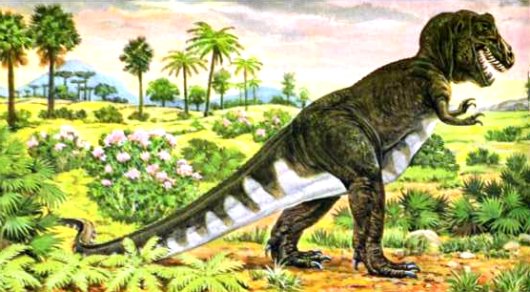 |
|
|
-
TRICERATOPS (Tri-ser-a-tops)
was a giant horned dinosaur. The name means "three horns
on the face." This tough-looking fellow resembled a rhinoceros.
He was 20 to 30 feet in length, with a skull 7 feet long. His
best defense against meat-eating enemies was an active offense,
employing the long brow horns. He was a vegetable-feeder with
a beak like a parrot's and sharp teeth for chopping up plant
food. Triceratops lived in Montana and Wyoming in Cretaceous
times.
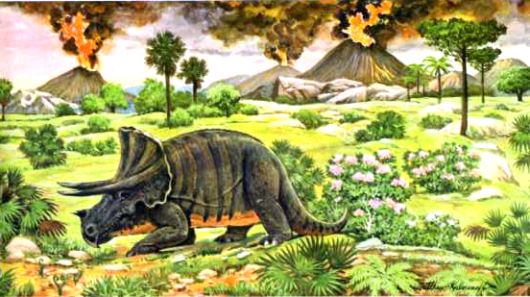 |
|
|
-
ANKYLOSAURUS (An-kyle-o-sawr-us)
was a walking fortress. The name means "curved lizard."
He was completely covered with bony armor which protected him
from bigger and stronger dinosaurs. He was about 20 feet long
and 6 feet wide. His skull was large, with an extra layer of
bony plates. The huge bony club at the end of his tail was mighty
useful as a weapon. Ankylosaurus was a plant-eater. He lived
in Western United States and Canada during the Cretaceous Period.
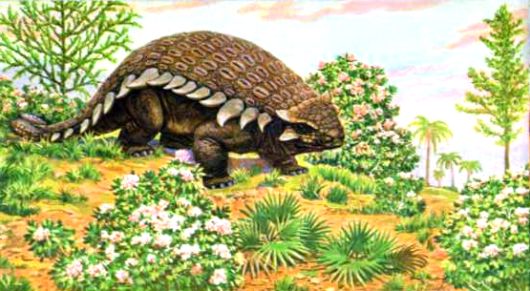 |
|
|
-
CORYTHOSAURUS (Kor-ith-o-sawr-us)
Although this duck-billed dinosaur averaged 30 feet in length,
he was no match for the flesh-eating dinosaurs of his time. He
lived in the water, may have eaten water plants, perhaps shellfish,
too. Corythosaurus means "helmet lizard" because of
the large crest on his skull, which resembled a Corinthian helmet.
He lived in North America during the late Cretaceous times. The
duckbills were the most abundant of the dinosaurs.
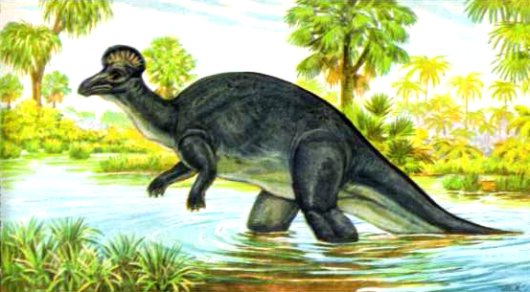 |
|
|
-
ORNITHOLESTES (Or-nith-o-les-tes)
weighted little more than a turkey. He was lightly built, had
many hollow bones. He lived in the last part of the Jurassic
Period in Wyoming. From such small, primitive reptiles came the
giant, flesh-eating dinosaurs of later times. Alert and fast-moving,
he probably fed on lizards and other small ground animals. His
skull was comparatively small. Ornitholestes was about 6 feet
in length, had a long tail, bird-like feet and sharp claws.
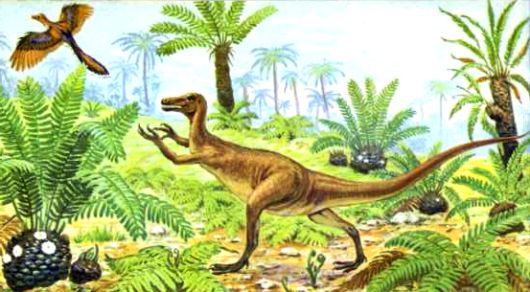 |
|
|
-
STEGOSAURUS (Steg-o-sawr-us)
The double row of bony plates on his back made him one of the
oddest-looking of all dinosaurs. Apparently, he fought with his
back to his enemies, defending himself with the 4 long spikes
on his tail. The front of his jaws formed a sort of beak. He
ranged from 18 to 25 feet long, weighed about 4 tons. This slow-moving
armored dinosaur fed on soft vegetation, lived in Western United
States during the Jurassic Period.
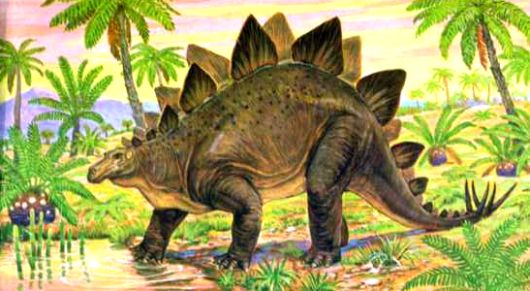 |
|
|
|
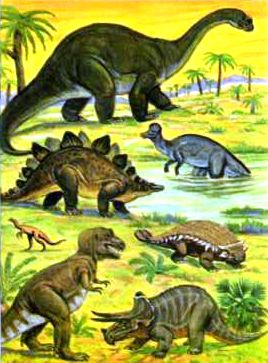
Dinosaurs,
although new extinct, dominated all the continents of the world
for more than 150 million years.
|
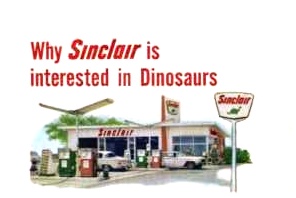
- Sinclair
uses the Dinosaur "Brontosaurus" as a symbol to dramatize
the age and quality of the crude oils from which Sinclair Petroleum
Products are made -- crudes which were mellowing in the earth
millions of years ago when Dinosaurs lived.
- Today,
Sinclair uses ultra-modern refining techniques to refine and
transform these age-old crudes into top-quality Sinclair Gasolines,
Motor Oils and other Petroleum Products for motor cars, the home,
the farm and for use in modern industry.
|
|
|
|
- STOP
AT THE SIGN OF THE Sinclair DINOSAUR
|
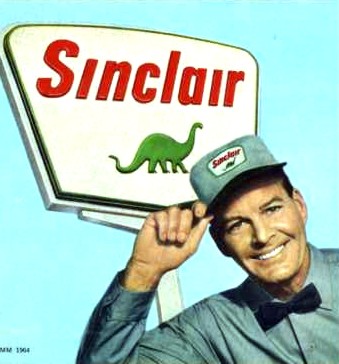 |
|
At Sinclair's multimillion-dollar
research laboratories in Harvey, Illinois, new petroleum products
are being developed and present products are being constantly
tested and improved.
You will find Sinclair
quality petroleum products for your car at the friendly Sinclair
Dealer in your neighborhood. He is one of 25,000 independent
Sinclair Dealers throughout the country.
- Drive with Care
- and Buy Sinclair
|
|
|
|